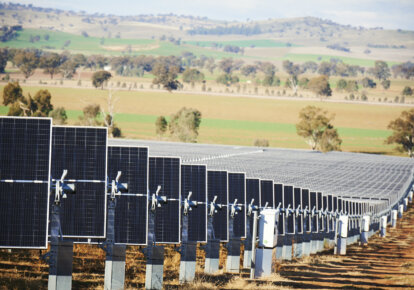High demand due to cool weather, continued high fuel costs, and variable renewable generation led to high average spot prices in July. The last days of the month saw peak prices escalate as cold and still weather saw high demand coincide with lower wind output.
Electricity price insights
In July, average underlying spot prices were slightly down across the National Electricity Market (NEM) when compared to June. However, there was significant price variability across the month, particularly when cold weather drove up peak demands (including new winter operational peak demand records in Victoria and Queensland) coincident with periods of low renewable output.
The NEM saw very high peak demand levels in July due to cold weather. Victoria set a new winter operational demand record on the evening of the 15th of July, comfortably breaking a record set 17 years earlier in July 2007. On this day, cold weather brought stormy conditions, leading to significant wind generation which limited price impacts. There were five other days that were in the top 20 of winter peaks this July, pointing to the underlying growth in demand in Victoria during cold weather. Additional demand spikes at the end of the month coincided with low wind output and saw peak prices spike to the level of the new Market Price Cap (increased on 1 July from $16,600/MWh to $17,500/MWh).
Queensland also set a new winter operational demand peak record on the evening of the 17th, beating a record set in July 2022. Temperatures in Brisbane on this day ranged from 7.6oC to 16.9oC, with a cool change moving north across the state during the day. Maximum temperatures for the majority of the state were 4-8 degrees below average, with indications the weather conditions had more people staying indoors.
High fuel costs also contributed to keeping energy prices high. July tends to be a peak demand month for gas with seasonal storages being drawn down for direct heating needs and electricity generation. Gas prices reduced in July compared with June as gas supply improved and the risk of running out of storage by the end of winter diminished, however they were still approximately 30% higher than July 2023.
On July 1 the domestic coal price cap introduced in 2022 concluded. This cap was introduced to handle the extreme volatility in energy prices resulting from Russia’s invasion of Ukraine. While Australian export coal prices are down ~70% from their peak in 2022, they still sit ~50% higher than the recently concluded cap, raising the operating cost of coal generators while coal prices remain elevated compared to historic levels.
Finally, July had significant variability in renewable generation. Total instantaneous renewable output in the NEM set a new record in early July, however by the last days of the month the cold, still weather saw very low renewable output over peak periods. Internal analysis indicates that daily wind generation is strongly negatively correlated with daily average price (i.e., higher-wind-generation days have lower average daily prices). These periods of low renewables (i.e. less supply) contributed to higher spot prices. While renewables push down prices when they’re abundant, this month again highlights the importance of complementary technologies like storage and demand flexibility.
Changes in forward contract prices for CY25
Forward prices for 12-month futures in all mainland regions concluded the month slightly lower than at the end of June (although have risen during the start of August due to a bout of high prices).

- New South Wales prices are up 8% from a year ago, and down 5% from June 2024
- Queensland prices are up 13% from a year ago, and down 6% from June 2024
- South Australia prices are down 3% from a year ago, and 8% from June 2024
- Victoria prices are up 12% from a year ago, and down 8% from June 2024
July 2024 NEM insights by state
New South Wales

- Average spot price of $127/MWh, with 28 hours of negative prices and 10 hours above $300/MWh
- $220/MWh difference in average underlying spot prices at the cheapest and most expensive times of day
- No daily intervals with an average negative price over the whole month
- 27% total renewable generation through the month
- Minimum demand of 6,223 MW
- Peak demand of 12,728 MW
Queensland

- Average spot price of $119/MWh, with 87 hours of negative prices and 23 hours above $300/MWh
- $260/MWh difference between the average underlying prices at the cheapest and most expensive times of day
- Average underlying price was negative from 12:35 PM to 1:05 PM
- 27% total renewable generation through the month
- Minimum demand of 3,996 MW
- Peak demand of 8,958 MW
South Australia

- Average spot price of $241/MWh, with 89 hours of negative prices and 48 hours above $300/MWh
- $200/MWh difference between the average underlying prices at the cheapest and most expensive times of the day
- No daily intervals with an average negative price over the whole month
- 65% total renewable generation through the month
- Minimum demand of 587 MW
- Peak demand of 2,550 MW
Tasmania

- Average spot price of $181/MWh, with 4 hours of negative prices and 28 hours above $300/MWh
- $130/MWh difference between lowest and highest time-based average underlying spot price
- No daily intervals with an average negative price over the whole month
- 86% total renewable generation through the month
- Minimum record of 1,135 MW
- Peak demand of 1,871 MW
Victoria

- Average spot price of $149/MWh, with 36 hours of negative prices and 25 hours above $300/MWh
- $170/MWh difference between lowest and highest time-based average underlying spot price
- No daily intervals with an average negative price over the whole month
- 32% total renewable generation through the month
- Minimum demand of 3,953 MW
- Peak demand of 8,776 MW
June temperatures
While the Bureau of Meteorology previously forecast a warmer and drier winter, July proved to be the second coldest in 12 years across the east coast, and significantly colder than last winter in each of the capital cities. Rainfall was a step up from June and largely in line with averages.
Looking ahead to August
The Bureau of Meteorology has again forecast higher-than-usual maximum and minimum temperatures across most the NEM, which may drive continued volatility. On the 5th of August, low renewable output again coincided with cold weather to drive significant price volatility – with all the mainland NEM states except Queensland seeing over 2 hours of very high prices in the morning, and all the mainland states except South Australia seeing over 2.5 hours of very high prices in the evening.
It is unusual for all the mainland states to experience very high prices at the same time, as spare room on the interconnectors between the states usually allows additional capacity to be used from elsehwere in the NEM. In the case of no spare capacity on the interconnectors, then only the state short on capacity would experience the high prices. However, on this day the consistent weather conditions across the NEM and outages of 6 coal units and 7 gas units left the whole NEM reliant on expensive backup generation and saw average prices for the day of over $2,000/MWh for VIC and NSW, over $1,000/MWh for QLD and SA, and just under $1,000/MWh for TAS.
Wind has picked up and prices have returned to less extreme levels following August 5th. With a short window of winter remaining the weather is likely to be the key determining factor between another bout of high prices, or a move into the expected lower prices of spring as solar and wind generation picks up and demand falls.
For rainfall, the Bureau has forecast a wetter-than-normal August for much of inland Australia, with average rainfall expected for Northern Queensland, Southern Victoria, and Tasmania.
The Bureau’s climate models remain in a weak “La Niña Watch” indicating that there are signs a La Niña may develop later this year. This would bring cooler than average maximum temperatures across most of mainland Australia (south of the tropics) and increased rainfall.
On the outage front, as we move out of the end of winter expect to see several coal units using the spring window to undertake maintenance. These outages are scheduled to begin in late August and September and are running through to November.
While initially planned to return on June 30th after more than 1000 days of outage, Unit C4 at Callide Power Station in Queensland pushed back its return to service date again to the end of August. On this date, it will return to partial capacity, and then ramp up to full capacity after further testing.
DISCLAIMER FROM FLOW POWER ABN 27 130 175 343: You must make your own independent decisions to enter into any transactions based on the information provided in this communication. You must not rely upon this or any other communication (written or oral) with us as financial or investment advice or as a recommendation to enter into a transaction. No communication (written or oral) received from us will be deemed to be an assurance or guarantee as to the expected results of any transaction.
Any questions? Our energy specialists are here to help.
If you’re an existing Flow Power customer, don’t hesitate to reach out to your account manager.
If you’re not a Flow Power customer, feel free to contact our friendly team:
1300 08 06 08
Alternatively, you can submit your questions through our website contact form here.














